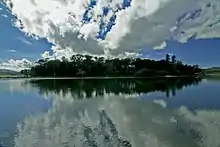Kincumber, New South Wales
Kincumber is a south-eastern suburb of the Central Coast region of New South Wales, Australia, nested between the Kincumba Mountain Reserve and the Kincumber Broadwater and located 91 kilometres (57 mi) north of Sydney via the Sydney-Newcastle Freeway (F3). It is part of the Central Coast Council local government area.
| Kincumber Central Coast, New South Wales | |||||||||||||||
|---|---|---|---|---|---|---|---|---|---|---|---|---|---|---|---|
.jpg.webp) | |||||||||||||||
| Population | 7,093 (2016 census)[1] | ||||||||||||||
| • Density | 887/km2 (2,296/sq mi) | ||||||||||||||
| Postcode(s) | 2251 | ||||||||||||||
| Area | 8.0 km2 (3.1 sq mi) | ||||||||||||||
| Location | |||||||||||||||
| LGA(s) | Central Coast Council | ||||||||||||||
| Parish | Kincumber | ||||||||||||||
| State electorate(s) | Terrigal | ||||||||||||||
| Federal Division(s) | Robertson | ||||||||||||||
| |||||||||||||||
A nature reserve, Kincumba Mountain, is located within the suburb and is often used by the community for various functions, including picnicking, bush-walking, orienteering, parties, and carnivals.
Kincumber is also a skateboarding hub of the Central Coast. It has two skate facilities, one in Frost Reserve and the other in South Kincumber recreation area.
History
The name stems from the local Aboriginal name of "Kincumba" meaning "towards the rising sun" or "to tomorrow".[2] A large open flat rock area at the highest plateau of Kincumba Mountain, which commands panoramic views of the region, was used by Kuringgai people as a meeting place and camp. Being the highest open position in the region, it was first to receive the morning sun as it broke over the eastern horizon Tasman Sea/Pacific Ocean, and so this area was also referred to as "towards tomorrow". Signs of habitation in the Kincumber area include axe-grinding grooves and rock engravings on Kincumba Mountain. Due to the freshwater creek, water access from Brisbane Water and the Hawkesbury River, and an abundance of old rainforest timber in the surrounding valley hills, Kincumber was one of the earliest settlements on the Central Coast, supplying wood for the needs of the growing colony at Sydney in the early 19th century.
Boat building became an early local secondary industry after timber-getting, to meet the primary necessity of water transport. Boat-building along Kincumber Creek continued until the early 20th century. The last ship was built in the area in 1906 by George Frost. It was called the SS Rock Lily.[3]

Kincumber was once home to a monazite processing plant that processed mineral sands mined in the local area. The plant was operated on the edge of Kincumber industrial estate, and backed on to Kincumber Creek. The site, "Lot 500", is now abandoned but still has higher than average levels of radiation and has been deemed unsafe for development.[4]
During the 1980s the town made international headlines for mistreatment of Eve van Grafhorst, a girl who contracted HIV through an infected blood transfusion, the last of eleven after her premature birth. Grafhorst and her family eventually were forced to move to Hastings, New Zealand by the people of the town, after Grafhorst bit a child at kindergarten in 1985 and was not allowed to return unless she wore a face mask. Soon after, the family was told by the Gosford City Council: "Withdraw your daughter from kindergarten or we will go public with the fact she has HIV". Grafhorst and her family lived a relatively normal life in Hastings, where she was permitted to attend school. Eve Van Grofhorst eventually died from the disease at age eleven in 1993.[5]
On 28 August 2000, the Olympic torch relay passed through Kincumber en route to the Sydney Olympic Stadium.
Population
According to the 2016 census there were 7,093 people in Kincumber.
- Aboriginal and Torres Strait Islander people made up 2.8% of the population.
- 80.2% of people were born in Australia. The next most common countries of birth were England 6.5% and New Zealand 1.4%.
- 92.5% of people spoke only English at home.
- The most common responses for religion were No Religion 26.1%, Catholic 25.2% and Anglican 24.1%.[1]
Facilities
As of January 2020, Kincumber has a high school, primary school, hotel, shopping centre, library, several restaurants, fast food outlets and a licensed post office[6] within a surf shop.
Politics
At a federal level, Kincumber is within the Division of Robertson. Previously held on a safe margin by Jim Lloyd of the Liberal Party, the seat changed hands in the 2007 Federal Election, and was held by the Australian Labor Party's Belinda Neal. In 2010 the seat was won by Labour member Deborah O'Neill.[7]
In the New South Wales Legislative Assembly, Kincumber is within the electorate of Terrigal, currently held by Chris Hartcher of the Liberal Party.
Polling place statistics are presented below combining the votes from the Kincumber, Kincumber Central and Scaysbrook polling places in the federal and state elections as indicated.
|
|
| ||||||||||||||||||||||||||||||||||||||||||||||||||||||
|
|
| ||||||||||||||||||||||||||||||||||||||||||||||||||||||
References
- Australian Bureau of Statistics (27 June 2017). "Kincumber (State Suburb)". 2016 Census QuickStats. Retrieved 21 December 2017.

- Gosford City Library. "Placenames". Archived from the original on 29 August 2007. Retrieved 21 July 2007.
- Kincumber, NSW at Aussie Towns website. Retrieved 26 January 2020
- Unwin, Greg L (1989), "Decommissioning of a mineral-processing facility in an urban environment", Australian Mining Industry Council. Environmental Workshop. Proceedings, 1 (1989): 188–196, retrieved 15 February 2012.
- Hunt, Tom. "Remembering Eve's fight against HIV". Stuff.co.nz. The Dominion Post. Retrieved 1 November 2014.
- LPO Information. Australia Post website
- Australian Broadcasting Corporation (21 December 2007). "Robertson (Key Seat) - Green Guide". Retrieved 29 January 2008.